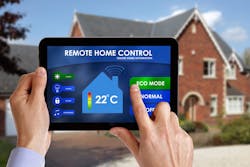Are Smart Homes Ready for Prime Time in the HVAC Industry?
Last month we published an editorial titled, “Connected Homes: The HVAC Contractor Connection," in which we postulated the potential future of that market and how it could change the industry. Since we published it, there has been an increase in consumer coverage of the same topic.
Interestingly, The Wall Street Journal and Time Magazine (among others) have presented very strong cases why consumers would want their homes to be “smart.” One reason: it’s cool. Or it’s hot. Depends on the season, I suppose.
But who is it cool for — the average consumer or the technogeek? What is driving this trend?
Today the creaters of gadgets and the sexiness of cloud-based Internet connection power, combined with a need to save energy and reduce our carbon footprint are the key drivers. Smartphone technology is already the fastest growing sector in communications and hand-held computing and the smart home phenomenon plays right into that.
But does all this cool tech make our lives easier? Does it do something so different that it’s simply too compelling to pass up? From an HVAC perspective, is it the next evolution of our industry?
The answer, right now, is maybe.
In a recent Wall Street Journal article, Tech Columnist Christopher Mims sees the entire smart home phenomenon as something that makes our lives more, not less complicated. Published on June 23, (bit.ly/DumbHome), Mims says the technology that powers smart homes — whether it’s from titans like Apple or Google, telecom giants like Verizon or AT&T, or startup companies like SmartThings or Revolv — forces people to think like engineers. He contends that most consumers aren’t engineers and just don’t think that way. I couldn’t agree more and I’m a self-professed gadget geek.
He also says that people like Tony Fadell, CEO of Nest Labs, may have the right idea in their vision to create uncomplicated devices that make people’s lives easier. Mims quotes Nest head of marketing, Maxime Veron who says that Nest purposely didn’t make the thermostat programmable: “It’s an attempt to make technology adapt to the user instead of the other way around.”
Mims hopes that this trend will lead to a “hotbed of experimentation with things that transform how we live, instead of just adding complexity where we want it least.”
Again, I couldn’t agree more.
The July 7th issue of Time Magazine had a 39-page special report on the “The Smarter Home,” which I read with great interest. Time examined the advantages of having a home that anticipates your needs by being adaptable to users, creating unique environments with recycled materials that have great curb appeal, and are super efficient (combining hybrid technologies that save energy and reduce environmental impact).
In the article “This Startup is Trying to Create—and Control—the Internet of Your Home,” author Sam Frizell quotes research firm IHS Technology’s prediction that by 2018, people will have installed 45 million smart home services and that the smart home market will achieve around $12 billion in annual business within five years (bit.ly/InetOfHome).”
The entire issue is a great read, but I found one sentence in the Frizell article that summed it up succinctly for me. He said, “The main challenge (to Smart Home Technology) is raising awareness (about it).”
That point rings very true, especially after a conversation I recently had with HVAC contractor Steve Miles of Jerry Kelley HVAC in St. Charles, MO.
Steve said, “The connected house concept is interesting, but I honestly don’t know how many people understand what that is or why they would want it right now. This doesn’t mean it won’t be in demand down the road. It’s just not ready for prime time yet.”


